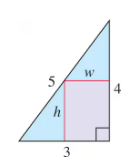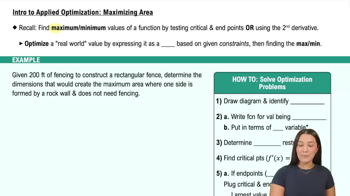The ladder problem What is the approximate length (in feet) of the longest ladder you can carry horizontally around the corner of the corridor shown here? Round your answer down to the nearest foot.
Table of contents
- 0. Functions7h 54m
- Introduction to Functions16m
- Piecewise Functions10m
- Properties of Functions9m
- Common Functions1h 8m
- Transformations5m
- Combining Functions27m
- Exponent rules32m
- Exponential Functions28m
- Logarithmic Functions24m
- Properties of Logarithms36m
- Exponential & Logarithmic Equations35m
- Introduction to Trigonometric Functions38m
- Graphs of Trigonometric Functions44m
- Trigonometric Identities47m
- Inverse Trigonometric Functions48m
- 1. Limits and Continuity2h 2m
- 2. Intro to Derivatives1h 33m
- 3. Techniques of Differentiation3h 18m
- 4. Applications of Derivatives2h 38m
- 5. Graphical Applications of Derivatives6h 2m
- 6. Derivatives of Inverse, Exponential, & Logarithmic Functions2h 37m
- 7. Antiderivatives & Indefinite Integrals1h 26m
- 8. Definite Integrals4h 44m
- 9. Graphical Applications of Integrals2h 27m
- 10. Physics Applications of Integrals 3h 16m
- 11. Integrals of Inverse, Exponential, & Logarithmic Functions2h 31m
- 12. Techniques of Integration7h 41m
- 13. Intro to Differential Equations2h 55m
- 14. Sequences & Series5h 36m
- 15. Power Series2h 19m
- 16. Parametric Equations & Polar Coordinates7h 58m
5. Graphical Applications of Derivatives
Applied Optimization
Problem 4.5.35
Textbook Question
35. Determine the dimensions of the rectangle of largest area that can be inscribed in the right triangle shown in the accompanying figure.

 Verified step by step guidance
Verified step by step guidance1
Identify the right triangle with legs of lengths 3 and 4, and hypotenuse 5. The rectangle is inscribed such that one vertex is at the right angle, and the opposite vertex is on the hypotenuse.
Let the width of the rectangle be 'w' and the height be 'h'. The area of the rectangle is given by A = w * h.
Use similar triangles to express 'h' in terms of 'w'. The triangle formed by the hypotenuse and the rectangle is similar to the original triangle, so the ratio of corresponding sides is equal: h/3 = (4-w)/4.
Solve the equation from the similar triangles to express 'h' in terms of 'w': h = 3(4-w)/4.
Substitute the expression for 'h' into the area formula: A = w * (3(4-w)/4). Differentiate A with respect to 'w', set the derivative equal to zero, and solve for 'w' to find the dimensions that maximize the area.
 Verified video answer for a similar problem:
Verified video answer for a similar problem:This video solution was recommended by our tutors as helpful for the problem above
Video duration:
7mPlay a video:
Was this helpful?
Key Concepts
Here are the essential concepts you must grasp in order to answer the question correctly.
Optimization
Optimization involves finding the maximum or minimum value of a function within a given set of constraints. In this problem, the goal is to maximize the area of the rectangle inscribed in the right triangle. This requires setting up an equation for the area in terms of the rectangle's dimensions and using calculus techniques to find the maximum value.
Recommended video:

Intro to Applied Optimization: Maximizing Area
Similar Triangles
Similar triangles have proportional sides and identical angles. In this problem, the inscribed rectangle creates two smaller triangles within the right triangle. By using the properties of similar triangles, we can express the dimensions of the rectangle in terms of the triangle's sides, which is crucial for setting up the optimization problem.
Recommended video:

Definition of the Definite Integral
Derivative Test
The derivative test is used to determine the local maxima and minima of a function. After expressing the area of the rectangle as a function of one variable, taking its derivative and setting it to zero helps find critical points. Evaluating the second derivative at these points confirms whether they correspond to a maximum or minimum area.
Recommended video:

The Second Derivative Test: Finding Local Extrema

 1:13m
1:13mWatch next
Master Intro to Applied Optimization: Maximizing Area with a bite sized video explanation from Patrick
Start learningRelated Videos
Related Practice
Textbook Question
